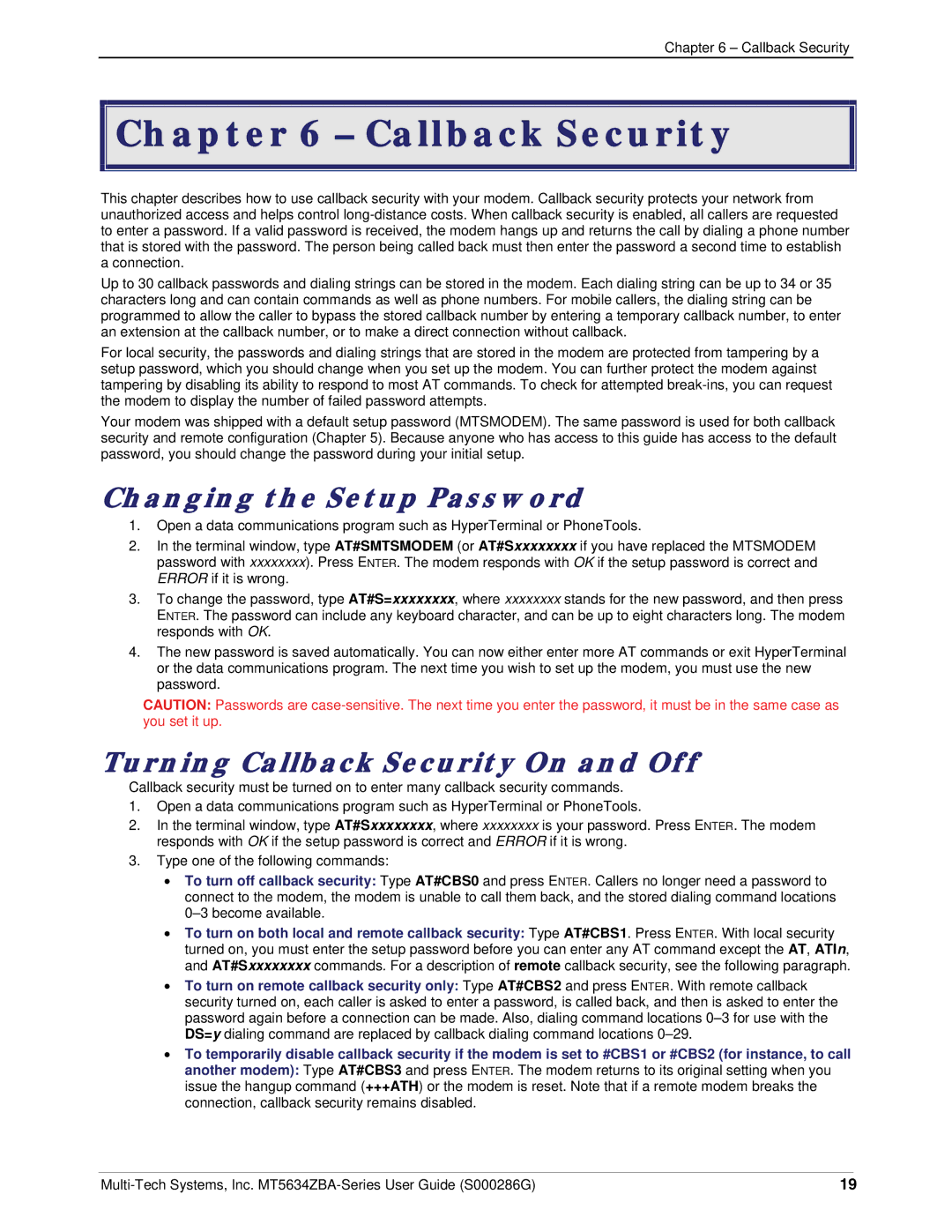
Chapter 6 – Callback Security

 Chapter 6 – Callback Security
Chapter 6 – Callback Security
This chapter describes how to use callback security with your modem. Callback security protects your network from unauthorized access and helps control
Up to 30 callback passwords and dialing strings can be stored in the modem. Each dialing string can be up to 34 or 35 characters long and can contain commands as well as phone numbers. For mobile callers, the dialing string can be programmed to allow the caller to bypass the stored callback number by entering a temporary callback number, to enter an extension at the callback number, or to make a direct connection without callback.
For local security, the passwords and dialing strings that are stored in the modem are protected from tampering by a setup password, which you should change when you set up the modem. You can further protect the modem against tampering by disabling its ability to respond to most AT commands. To check for attempted
Your modem was shipped with a default setup password (MTSMODEM). The same password is used for both callback security and remote configuration (Chapter 5). Because anyone who has access to this guide has access to the default password, you should change the password during your initial setup.
Changing the Setup Password
1.Open a data communications program such as HyperTerminal or PhoneTools.
2.In the terminal window, type AT#SMTSMODEM (or AT#Sxxxxxxxx if you have replaced the MTSMODEM password with xxxxxxxx). Press ENTER. The modem responds with OK if the setup password is correct and ERROR if it is wrong.
3.To change the password, type AT#S=xxxxxxxx, where xxxxxxxx stands for the new password, and then press ENTER. The password can include any keyboard character, and can be up to eight characters long. The modem responds with OK.
4.The new password is saved automatically. You can now either enter more AT commands or exit HyperTerminal or the data communications program. The next time you wish to set up the modem, you must use the new password.
CAUTION: Passwords are
Turning Callback Security On and Off
Callback security must be turned on to enter many callback security commands.
1.Open a data communications program such as HyperTerminal or PhoneTools.
2.In the terminal window, type AT#Sxxxxxxxx, where xxxxxxxx is your password. Press ENTER. The modem responds with OK if the setup password is correct and ERROR if it is wrong.
3.Type one of the following commands:
•To turn off callback security: Type AT#CBS0 and press ENTER. Callers no longer need a password to connect to the modem, the modem is unable to call them back, and the stored dialing command locations
•To turn on both local and remote callback security: Type AT#CBS1. Press ENTER. With local security turned on, you must enter the setup password before you can enter any AT command except the AT, ATIn, and AT#Sxxxxxxxx commands. For a description of remote callback security, see the following paragraph.
•To turn on remote callback security only: Type AT#CBS2 and press ENTER. With remote callback security turned on, each caller is asked to enter a password, is called back, and then is asked to enter the password again before a connection can be made. Also, dialing command locations
•To temporarily disable callback security if the modem is set to #CBS1 or #CBS2 (for instance, to call another modem): Type AT#CBS3 and press ENTER. The modem returns to its original setting when you issue the hangup command (+++ATH) or the modem is reset. Note that if a remote modem breaks the connection, callback security remains disabled.
19 |
